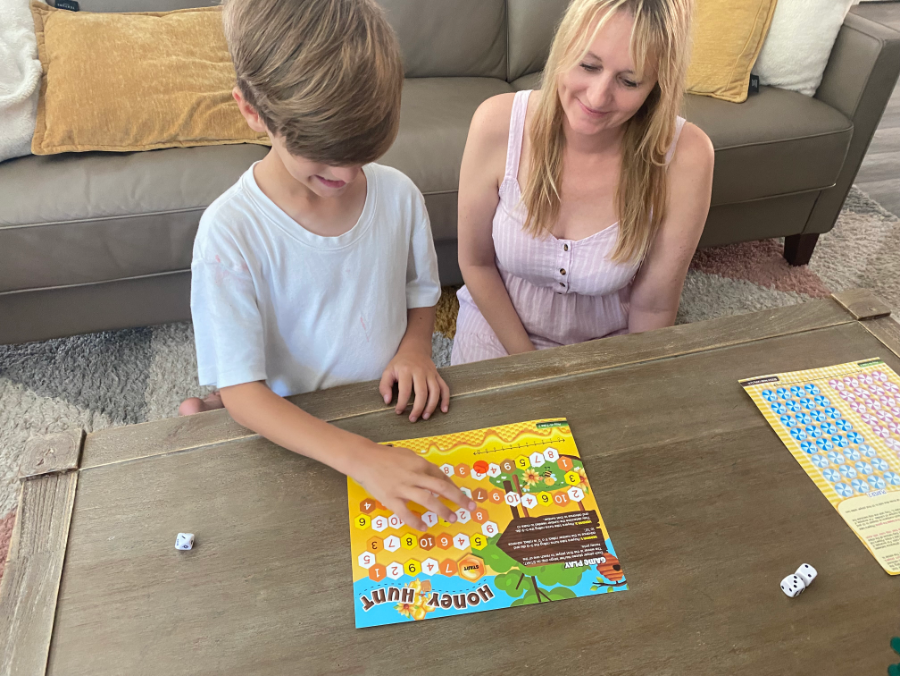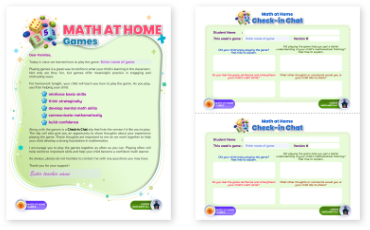
One of our goals at Math Unity has always been to engage families in fun hands-on math activities that are linked to learning. We know that when schools and families partner together around the common goal of educating students, learning improves and students make greater academic gains. The objective for this study was two-fold. The first was to see if our games engaged families in hands-on math in a way that reinforced essential math skills. The second was to see if our Check-In Chats supported meaningful parent*/teacher communication.
We recruited 13 teachers from two schools in California to participate in our study. The first school was located in northern California with 42% of students scoring at or above proficient in math. 44% of the students were considered economically disadvantaged. Four teachers participated from grades TK, K, 2, and 4.
The second school was located in central coast California with 10% of students proficient in math. This was a Title 1 school and most of the parents spoke only Spanish. 94.9% of students were Hispanic/Latino. Nine teachers participated from grades K, 1, 3, and 5.
Games: Our Take-Home math games are organized into 'levels' by the grade bands: TK-1st (Beginning Level), 2nd - 3rd (Intermediate Level), 4th - 5th (Advanced Level). All of the games have at least two versions of play except Rainforest Remainders (Advanced Level) which only has one version. Version 1 is the easiest to play with each additional version increasing in difficulty.

We sent each teacher the requested number of games for each student in their class. The teachers at School #2 requested games in both English and Spanish. The table below lists the specific math games and the number of English and/or Spanish games the teachers received:
| Grade Level | # of Games Sent | Game | From Take-Home Kit |
|---|---|---|---|
| TK | 23 English | Chicken Chase | Play-N-Take 2 |
| K | 21 English | Mushroom Match | Play-N-Take 2 |
| 2 | 23 English | Evens vs Odds and Rabbit Race | Play-N-Take |
| 2 | 23 English | Rabbit Race | Play-N-Take 3 |
| 4 | 30 English | Apple Arrays | Play-N-Take 3 |
| Grade Level | # of Games Sent | Game | From Take-Home Kit |
|---|---|---|---|
| K | 17 Spanish | Jump Home | Play-N-Take |
| K | 1 English, 18 Spanish | Honey Hunt | Play-N-Take 3 |
| K | 1 English, 14 Spanish | Go 4 the Win | Make-N-Take |
| K | 19 Spanish | Chicken Chase | Play-N-Take 2 |
| 1 | 3 English, 23 Spanish | Line 'em Up | Play-N-Take |
| 1 | 2 English, 21 Spanish | Candy Count | Play-N-Take 3 |
| 3 | 2 English, 19 Spanish | Chocolate Challenge | Play-N-Take 2 |
| 5 | 5 English, 23 Spanish | Rainforest Remainders | Play-N-Take 2 |
| 5 | 4 English, 20 Spanish | Frog Fractions | Play-N-Take 3 |
Family Letter and Check-In Chat: Along with each game we included a family letter. The letter introduced families to the game and explained why playing games is a great way to reinforce skills, think strategically, develop mental math skills, communicate mathematically, and build confidence.

Because parent/teacher communication was an important part of this study, we also included a Check-In Chat slip for parents/caregivers to use after playing the game to encourage the home/school communication. The Check-In Chat slip asked four simple questions:
We randomly chose games from our Play-N-Take, Play-N-Take 2, Play-N-Take 3, and Make-N-Take Take-Home kits and sent each teacher their own box filled with the number of games they requested. The games were pre-packaged with the family letter and Check-In Chat to make it easy for them to be sent home with students.
Included in the teacher box of games was a sheet with a QR code. Although the directions to play the games was included on each game board, the QR code gave the teachers access to the video directions of their game.
After receiving the box of games, teachers explained to their students that they would be learning how to play a new game and that the game would be going home with them so they could play with their families. All teachers taught their students version 1 of their game. One kindergarten teacher also taught a select few of her students version 2 of their game. Another kindergarten teacher and the third grade teacher taught version 1 and version 2 of their game.
In TK and K, working in small groups, the students were taught the game and then teachers paired students with a partner. Partners were monitored as they played together to make sure they understood the game. In grades 1-5, students were taught the game as a whole class then students were paired up to play the game with their partner.
Once students had practice playing the game, the games were sent home to play with their parent/caregiver. Included with the game was the family letter and Check-In Chat slip. Families where the Spanish version of the game was sent home received the family letter and Check-In Chat in Spanish.
At home after families played the game, parents filled out the Check-In Chat slip and returned the slip to school the following day. The games stayed home with the students*. For those families that filled out the Check-In Chat in Spanish, we had a translator re-write the comments for us in English. The teachers reviewed the Check-In Chat comments and then mailed us their slips. To make it convenient, we provided each teacher with a self-addressed stamped envelope.
*Normally the games would go back to school but for this case study, the games were donated to each family.
Although the families were only "required” to play version 1, two of the second graders, 10 of the Kindergarteners, five of the third graders, and all of the fourth graders indicated they tried some of the other versions.
The tables below show how many Check-In Chat responses we received back from each teacher:
| Grade Level | Check-In Chats Returned | Game |
|---|---|---|
| TK | 20 English | Chicken Chase |
| K | 12 English | Mushroom Match |
| 2 | 17 English | Evens vs Odds and Rabbit Race |
| 2 | 10 English | Rabbit Race |
| 4 | 12 English | Apple Arrays |
| Grade Level | # and Language of Game | Game |
|---|---|---|
| K | 5 Spanish | Jump Home |
| K | 1 English, 15 Spanish | Honey Hunt |
| K | 1 English, 4 Spanish | Go 4 the Win |
| K | 9 Spanish | Chicken Chase |
| 1 | 2 English, 5 Spanish | Line 'em Up |
| 1 | 0 English, 0 Spanish | Candy Count |
| 3 | 2 English, 16 Spanish | Chocolate Challenge |
| 5 | 5 English, 10 Spanish | Rainforest Remainders |
| 5 | 3 English, 10 Spanish | Frog Fractions |
Sending games home to play turned out to be a great way to engage families in hands-on math. Because games are inherently fun to play it was easy to get families to participate. In addition, the Check-In Chat helped parents focus on their child's mathematical learning as they played the game. We know this because we were pleasantly surprised at the quality of Check-In Chat comments we received from parents. The comments showed that they were clearly engaged in paying attention to their child's mathematical thinking and problem-solving.
We also learned that parents (and kids!) felt playing games was a great way to practice skills. The overwhelming comment we received was for more games. This told us that our math games engaged students in purposeful practice in a way that empowered parents to support learning at home.
As teachers were teaching their students to play the games, they observed that students were getting a lot of skill repetition which was helping with fact fluency and mental math. Several of the teachers commented that they would now be sending home more games to play.
We hadn't considered that having students teach their parent (or sibling!) how to play the game was actually a great way for them to solidify their understanding and build math confidence. Both of these are so important in becoming great little mathematicians.
As mentioned above, the Check-In Chat helped parents focus on their child's mathematical learning as they played the game. But, just as importantly, the Check-In Chat served as a way to foster genuine collaboration between home and school in a way that underscored the shared goal of student success.
Unfortunately, we don't often give parents the opportunity to share their thoughts about their child's learning. And that's too bad because parents have a lot to offer and teachers can gain knowledge about their students' learning at home. So we were encouraged by how many of the Check-In Chats were returned as this was an indication that parents and caregivers really do want to be seen as partners in the education of their children.
One teacher summed up the parent comments by saying, “We need to send more games home because they're fun to play, engaging, and strengthen math skills.”
Research shows that early math skills are a strong predictor of a child's success in school and beyond. Research also shows that there is a strong relationship between family engagement and student academic success.
We set out to see if our math games and Check-In Chat helped support academic achievement through reinforcing essential skills and encouraging meaningful home/school communication. The comments we received from both teachers and parents confirmed that not only do our math games reinforce essential skills but they do it in a way that engages parents as valued partners in the education of their children. And we know it's a win for both home and school when we hear students comment, “I had fun playing with my family. Please send home more games!”